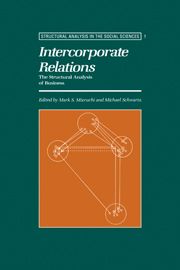Book contents
- Frontmatter
- Contents
- List of figures
- List of tables
- Introduction
- I Theoretical perspectives
- II National and international business structures: a comparative perspective
- 6 The structure of class cohesion: the corporate network and its dual
- 7 Intercorporate structures in Western Europe: a comparative historical analysis
- 8 The articulation of power and business structures: a study of Colombia
- 9 Business–government relations in modern Japan: a Tōdai–Yakkai–Zaikai complex?
- 10 International bank capital and the new liberalism
- Index of authors
- Subject index
7 - Intercorporate structures in Western Europe: a comparative historical analysis
Published online by Cambridge University Press: 04 February 2010
- Frontmatter
- Contents
- List of figures
- List of tables
- Introduction
- I Theoretical perspectives
- II National and international business structures: a comparative perspective
- 6 The structure of class cohesion: the corporate network and its dual
- 7 Intercorporate structures in Western Europe: a comparative historical analysis
- 8 The articulation of power and business structures: a study of Colombia
- 9 Business–government relations in modern Japan: a Tōdai–Yakkai–Zaikai complex?
- 10 International bank capital and the new liberalism
- Index of authors
- Subject index
Summary
The aim of this chapter is to discuss the structural features of big business in the major West European countries. The countries chosen for study are not intended as the basis of a comprehensive survey of West European economies. Rather, they are drawn from the work of a research group which has carried out the first truly comparative investigation of intercorporate structure. The countries selected do, however, constitute all the major economic powers and their trading partners and associations. The countries to which most reference is made are Britain, France, Germany, Italy, the Netherlands, Austria, and Switzerland. The obvious omissions from this list are the countries of the Iberian peninsula and Scandinavia, both of which areas have peculiar and distinct features which set them apart from the major industrial economies.
The research group on intercorporate structure, referred to in the text as the “Bad Homburg Group” after the town in which many of the group meetings took place, brought together researchers from a number of countries to collaborate on an investigation into interlocking directorships in ten countries. In addition to the countries mentioned above, there were participants from the USA (see the chapter by Bearden and Mintz in this book) and Finland, together with a “transnational” team (see the chapter by Fennema and van der Pijl in this book). The study involved the collection of comparable data in each of the countries and the use of the same set of computer programs, computer analysis being carried out centrally at Groningen University.
- Type
- Chapter
- Information
- Intercorporate RelationsThe Structural Analysis of Business, pp. 208 - 232Publisher: Cambridge University PressPrint publication year: 1988
- 27
- Cited by



